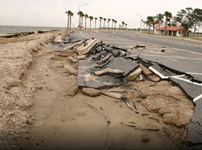Timely Reconstruction

This section explores the economic gains from speed and reliability through two papers. Hallegatte’s elegant rule of thumb estimates the total economic cost of a disaster, beyond the direct loss of assets.
De Janvry, del Valle, and Sadoulet report on an impact evaluation of Mexico’s fund for natural disasters, FONDEN: the faster reconstruction of infrastructure assets made possible by FONDEN’s disaster risk finance strategy contributes, on average, to an increase in postdisaster local economic activity of 2–4 percent
Being able to quantify the total loss to an economy from a disaster is a key component when trying to determine the importance of disaster risk finance. Essentially, two categories of losses must be considered. Direct losses are the assets lost because of the disaster. Indirect losses, also called output losses, are the reduced production and income stemming from the asset losses, including all adverse long-term consequences for economic growth resulting from the disaster. The latter can be extremely challenging to quantify accurately.
Hallegatte (2015) develops a theoretical model to motivate a simple, intuitive rule of thumb for measuring output losses. The rule takes into account constraints that render it impossible to immediately reallocate assets to their most efficient uses, as well as ripple and stimulus effects.
Ripple effects appear in infrastructure and utility services—for example, a house itself may not be damaged, but the owner still has to relocate because there is no running water. Or the damaged part of a road prevents the rest of the road from being used. More generally, the stock of capital consists of complementary assets; the destruction of one part may reduce the productivity of other parts.
The stimulus effect refers to the ability of an economy to react to the new production constraints (such as road closure) and the increase in demand for reconstruction through input substitution, production rescheduling, or mobilization of existing idle resources. This effect can lead to an increase in economic output beyond the pre-disaster level and can be seen as positive even though a classical stimulus policy could have the same effect without the negative welfare and human impacts of the disaster.
In this model, one dollar of direct loss in productive capital translates into a decrease in instantaneous (annualized) output that is equal to the average productivity of capital. This decrease in output is about three times the interest rate and may be increased by a factor that represents ripple effects and the duration of reconstruction.
Along these lines, the rule of thumb includes the interest rate, the decreasing return in the production function (also equal to the share of profits in national income), and the instantaneous and dynamic resilience—that is, the ability to limit damage and reconstruction. The latter comprises the reconstruction duration (longer reconstruction increases welfare losses) and a ripple effect factor that increases or decreases immediate losses. This factor is negative if enough idle resources are available to cope; positive if cross-sector and supply-chain issues impair the production of non-affected capital.
A disaster that causes capital losses equal to US$500 million, for example, in a country with a 10 percent interest rate and with a reconstruction period likely to span three years, would lead to total (asset plus output) losses of US$725 million (145 percent of direct capital losses), with a discounted value of US$650 million (130 percent of direct losses).
Given the cost of financing post-disaster reconstruction, it is important to understand whether such reconstruction can have a considerable impact on local economic activity. This research presents unique evidence on the impact of disaster risk finance on economic activity in a long-established program for the reconstruction of public assets.
Federal and state governments in Mexico spend almost US$1.5 billion annually on the reconstruction of public assets and low-income housing after natural disasters, and this amount can be much larger in bad years. In 2010 alone, the reconstruction after major floods totaled over US$5 billion. In response to the recurrent need for post-disaster budget reallocations to finance reconstruction, the Government of Mexico established the Fund for Natural Disasters (FONDEN) in 1996. Its original mandate was to provide adequate financial resources for federal and state reconstruction efforts without compromising committed government spending.
De Janvry, del Valle, and Sadoulet (2016) focus on the peril that represents 68 percent of all events that led to financial support from FONDEN—heavy rainfall. They analyze a 10-year period (2004-2013) in which road reconstruction dominated expenditures and they estimate FONDEN's impact on economic activity at different points in the post-disaster period. The expected effect, quickly reconstructed infrastructure and housing accelerated the resumption of economic activity.
The researchers use a regression discontinuity design to identify this effect. They turn to high-resolution satellite measures of night lights as a proxy for the differential economic performance created by the provision of rapid reconstruction funds through FONDEN. And they use quarterly employment data as a high-frequency measure of local employment after a disaster.
Overall, they estimate that FONDEN boosts local economic activity between 2 and 4 percent in the year following an event.
Is this effect worth the resources absorbed by FONDEN? The researchers find that the benefit to the economy in the year after the disaster is substantially greater than the total government expenditure, with a benefit-cost ratio of between 1.52 and 2.89. Although this range of ratios is quite broad, it does suggest that FONDEN is likely to provide benefits in excess of its cost.
The scale of gains to local economic activity brought about by the availability and rapid disbursement of disaster funds in the Mexican program could encourage policy makers in other countries to consider using disaster risk finance schemes such as FONDEN to enhance their own response capabilities.